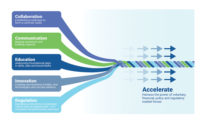 |
| Alarm would not prevent property damage, but would save lives. (Photo courtesy of Stewart Ritchie) |
The deadly tsunami that swept through South Asia on Dec. 26 immediately prompted calls for an early warning system. The Indian government was among the first, followed quickly by United Nations officials, to suggest that the world should put in place an Indian Ocean warning system fashioned after the one already in place in the Pacific Ocean. On Jan. 6, U.S. Sen. Joseph Lieberman (D- Conn.) proposed a $30-million expansion of the system that would include the Atlantic as well as the Indian Ocean.
If the earthquake and resulting tsunami that happened last week had occurred in the Pacific, we wouldnt have had nearly as much carnage, said Stuart Weinstein, a geophysicist and watchstander for the National Weather Services Pacific Tsunami Warning Center (PTWC) based in Ewa Beach Hawaii.
The reason Weinstein can be so sure is that he is at the epicenter of a multi-national effort that began in 1949 to monitor seismic activity in the between Japan and the Americas. PTWC uses a network of coastal tide stations on the surface and six pressure sensors embedded on the oceans surface at known quake sites to get an accurate view of tidal activity. Each of 120 coastal stations comprises one to four buoys that measure sea level changes.
|
The deepwater sensors, called Deep-ocean Assessment and Reporting of Tsunamis Mooring Systems (DART), are costly, but they add another dimension to forecasting, says Weinstein. It is much easier to model in deep water without the complex geometry of the coastline, he notes. Seattle, Wash.-based Pacific Marine Environment Laboratories, working with the National Oceanic and Atmospheric Administration, developed these seafloor bottom-pressure recording devices. The battery-powered sensors are anchored to the ocean floor. They monitor seawater pressure with a resolution of approximately 1 mm every 15 seconds on average. The system employs acoustic telemetry to send a signal every hour to a pair of control unit companion transducers floating on the surface. Data showing a disturbance as small as 1 cm, kicks the device goes into Tsunami Response Mode. Information is sent via a global positioning satellite special channel through a antenna to a network of dedicated watchers. They are trained to notify those in danger when appropriate.
Because each DART is about $250,000 and it takes that much again to install them, PTWC has about half the number it would like to have and none are In place in the Indian or Atlantic oceans. Weinstein estimated that it would take about eight DARTs located in the Java Trench, the Bay of Bengal and the Sumatran coast. The rub is that even if scientists had the data they needed to detect the rumbling, there was no communication system to disseminate the information. Likewise, few people in the death zone had been trained to recognize crucial warning signs. Few knew to run as incoming immense waves generated the deadly "draw-down" effect. Many of the victims, particularly children, instead ventured toward the water at the worst possible time and met watery deaths when the peak of the wave rolled in.
While word may not have reached shores closest to the epicenter, other countries around the Indian Ocean could have been notified in time for people to reach higher ground.
Lieberman's proposal would add 40 to 50 of the DART-type sensors, with two-way capability, so that control modules could query collection center sites on the ocean floor for data, in addition to receiving transmissions. The bill earmarks about $10 million for hardware and an additional $20 million for implementation and maintenance. The U.S. Depts. of State and Commerce would be responsibile for administration, according to a statement from Lieberman's office.
Weinstein admitted that finding the money to pay for a warning center and emergency managers who could create evacuation plans and set up communication systems could prove difficult in a region where nations are barely rich enough to feed their people. History also plays a role: major tidal wave disasters occur in Indian Ocean roughly once every 200 years. The Pacific Ocean is much more seismically active, with seven tsunamis recorded in the past 100 years. For these reasons, it is essential that the United Nations and the developed nations step up to create a global warning system, Weinstein said. That might cost tens of millions, but it would be less than the billions it will take to recover from just this one disaster.


Post a comment to this article
Report Abusive Comment